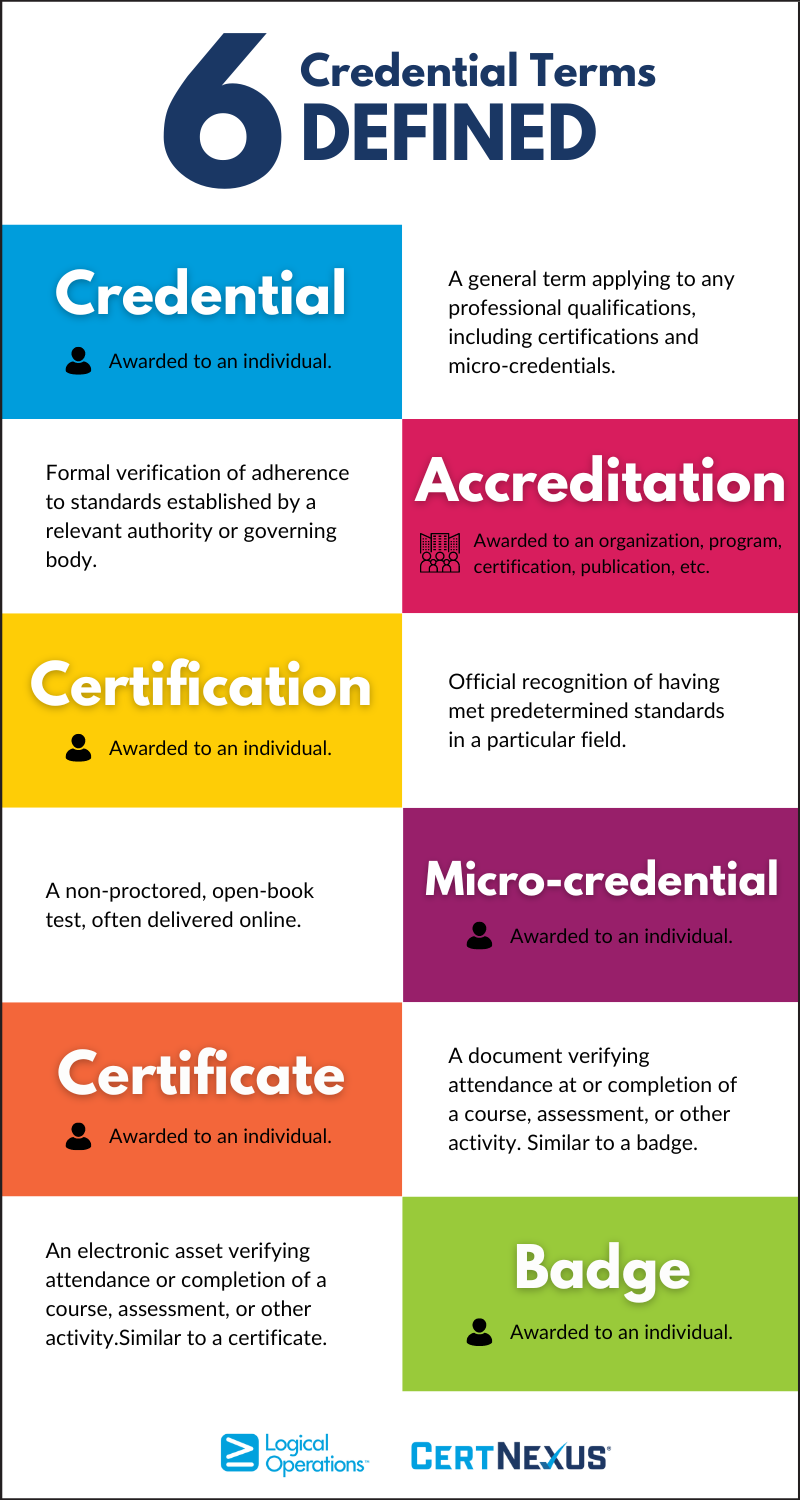The March issue of Logically Speaking shed some light on two key topics: the variety of terms used in the credentialing industry, and how to navigate the maze of emerging tech by using the CertNexus THINK portfolio. If you're confused about the credentialing industry or how to get started with emerging technology (or you need a refresher), this is a great place to start.

Is It a Certification or a Credential? The Top 6 Industry Terms Explained
by Tuuli Eaton, Global Head of Growth, Logical Operations/CertNexus
 |
Global Head of Growth Logical Operations/CertNexus |
During the last decade, the terminology for assessing expertise has significantly diversified and expanded. The credentialing industry has branched out to cater to learners who don't require full certification to achieve their learning goals. This has led to an increase in credential offerings, along with wide and sometimes casual use of a variety of credential-related terms. All of this has undoubtedly led to confusion. It doesn’t help that some of these terms may be used differently in varying professional and academic contexts. Particularly with the surge in demand for AI training, I’ve seen these terms being used interchangeably, muddying the waters and leading to unclear expectations.
Credentials and Credential Types
As an industry leader in professional emerging technology credentialing, CertNexus can help bring clarity from the confusion! I’d like to spend a few minutes clarifying the CertNexus usage of some key terms to ensure consistency and benefit learners.
- Credential
- Accreditation
- Certification
- Micro-credential
- Certificate
- Badge

Definitions by ChatGPT (Consistent with CertNexus Usage)
- Credential - The term "credential" serves as a broad umbrella encompassing various types of certifications, certificates, degrees, licenses, and other forms of recognition. Credentials validate an individual’s qualifications, achievements, or competencies and play a crucial role in assessing and verifying one’s professional capabilities. They serve as tangible evidence of skills and expertise, enhancing credibility and employability in the job market.
- Accreditation - is the process by which an institution, program, or organization is officially recognized as meeting certain quality standards set forth by accrediting bodies or regulatory agencies. Accreditation provides assurance that the entity adheres to established criteria for educational or professional excellence. Institutions seeking accreditation undergo rigorous evaluation processes to ensure compliance with predetermined standards.
- Certification - Certification typically refers to a formal process whereby an individual’s knowledge, skills, or competencies are evaluated against predetermined standards. Upon successful completion of the assessment, the individual is awarded a certification, often demonstrating their expertise in a specific subject matter or field. Certifications are commonly issued by professional organizations, industry associations, or certifying bodies.
- Micro-credential - Micro-credentials are focused, skill-specific credentials that validate competency in a particular area or skill set. Unlike traditional credentials, which may require extensive coursework or examination, micro-credentials are designed to be more targeted and flexible. They often cater to the needs of professionals seeking to enhance specific skills or knowledge areas in a shorter timeframe. Micro-credentials are gaining popularity in the era of lifelong learning and are offered by educational institutions, online platforms, and professional organizations.
- Certificate - A certificate is a document awarded to an individual upon the completion of a course, program, or training regimen. Unlike a certification, which often involves a standardized assessment process, a certificate may signify the completion of educational requirements without necessarily assessing competence. Certificates are offered by educational institutions, training providers, or online platforms and can vary widely in scope and duration.
- Badge - Badges are digital representations of achievements, skills, or accomplishments earned by individuals. They often accompany traditional credentials, providing a more granular and shareable way to showcase specific competencies or achievements. Badges can be earned through completion of courses, projects, or assessments and are increasingly utilized in online learning environments, professional development programs, and digital portfolios.
Industry Value of Certification
The highest-value technical credential in this multi-billion industry is of course a certification. Let’s take a moment to appreciate what it takes to create an industry-recognized certification. The key word here is industry-recognized. In other words, to adhere to independent standards for certification development, entities can’t create a true certification exam in a vacuum, or simply by consulting in-house experts. Measuring what has been written in a course alone also does not equal certification, especially if the course was created before the exam. The most commonly accepted industry process is exactly the opposite; the exam drives the course, the course doesn’t drive the exam.
The Certification Development Process
In a formal certification development process:
- The certification body convenes a structured, supervised Job Task Analysis with qualified independent subject matter experts to generate the certification exam blueprint, exam content outline, or other governing exam document. (Note that once the blueprint is published, training curriculum development can begin, in parallel with but separate from exam content development.)
- Another panel of subject matter experts follows established guidelines to write, review, and accept the initial pool of exam items.
- A beta exam is held for a minimum number of qualified candidates. The course developers may be permitted to take the beta exam but have no other access to the exam item pool.
- Psychometricians evaluate the beta exam results statistically and invalidate any outlier items.
- Another panel of subject matter experts establishes the exam passing score.
- The certification exam is published.
CertNexus is proud of our rigorous approach to certification development, which adheres to the International Organization Standardization (ISO) 27001 principles and is accredited by the American National Standard Institute (ANSI) National Accreditation Board (ANAB ISO/IEC 17024:2012). The process takes months, but it is all worth it. There is no reward higher than having a satisfied individual earn that certification and see an improvement in job prospects, career achievements, or professional self-development goals. Seeing that positive outcome for the exam candidate makes it all worthwhile for us.
So, next time you see an online conference being held promising all attendees a lifetime “certification” without passing a proctored examination, do us all a favor and call them out!
Technical Credentials and Your Professional Future
I hope I’ve clarified the distinctions between terms like certification, certificate, accreditation, micro-credential, credential, and badge, and I hope I’ve convinced you how this understanding is essential for navigating the complex landscape of professional development and recognition. With consistent and clear use of these terms and their respective roles, individuals can make informed decisions about their educational and career pathways, while organizations can ensure consistency and transparency in credentialing practices. Embracing the diversity of credentials and embracing lifelong learning will be key in thriving in the dynamic global marketplace of the future. Would you agree?
THINKing Your Way to Success - Using the CertNexus THINK Portfolio to Demystify Emerging Tech
by Kevin Rock, VP, Partners and Programs, Logical Operations/CertNexus
Leadership and Emerging Technologies
 |
VP, Partners and Programs Logical Operations/CertNexus |
I recently attended a conference where I was surprised and perplexed to hear about the misinformation and lack of understanding among industry leaders and decision makers regarding today’s high-impact and rapidly-evolving emerging technologies. This is especially true for the key concepts regarding generative AI, traditional predictive AI, data science, and machine learning. It even extends to issues with smart devices and the data they generate, and how ordinary users can best keep all this data secure.
This lack of understanding doesn’t only lead to bad organizational decision-making and poor business outcomes; it can have negative impacts on society at large. And that affects ALL of us.
The information and guidelines packed into the CertNexus THINK portfolio can help all business professionals harness these technologies productively and deploy them ethically, to the advantage of their organizations and for the greater social good.
The Challenges: AI Case Studies
Here are just a few AI-related examples to demonstrate the confusion and issues currently arising from emerging technologies:
- There is general misunderstanding and little distinction between thin/weak/narrow AI, general AI, and generative AI (GenAI). Without these fundamental concepts, there’s no way for organizations to have productive discussions or produce good decisions about AI implementation.
- There is fear being spread around "conscious" AI that is just not reality. Two chatbots “talking” to each other doesn’t mean that GenAI tools are sentient! There is no self-awareness or intent in that “conversation.” The bots are simply using each others’ outputs as inputs, and reacting to those inputs in the way their models were trained.
- Few people—whether in business or in the general public—grasp the true extent and likelihood of GenAI “hallucination” or “confabulation.” Every GenAI model can hallucinate spontaneously or can be manipulated into confabulating. The completely incorrect results can sound completely plausible because GenAI output is designed to sound natural, human, and believable. For safety and accuracy, human beings MUST review and verify all GenAI output before they act on it. Is your organization doing that?
- Finally, the Texas A&M case study, while specific to academia, is a great cautionary example of how the misapplication of GenAI can have real human consequences.
AI is the single most important technological advancement in decades. Misinformation like this muddies the waters and can create poor decision-making—and that leads to business losses, reputational debacles, and even social harm.
The Challenges: Other Emerging Tech Scenarios
The challenges for organizations and business professionals are by no means limited to AI. Generative AI might be the most newsworthy technology right now, but you don’t have to look far in mainstream media to turn up examples of other concerns regarding emerging tech:
- The intrusive or dangerous capabilities of Internet-enabled IoT devices on both the consumer and industrial levels.
- How misuse or misinterpretation of big data drives poor business decision-making.
- How irresponsible, uninformed, or unethical applications of data gathering, data mining, machine learning, and AI threaten personal privacy, damage businesses and brands, and cause social harm.
- How human error, confusion, and simple naïveté expose organizations of all types and sizes to the worst security failures and data losses.
The Solution
The CertNexus THINK portfolio provides vendor-neutral, impartial, technically sound coverage of the fundamentals of core emerging technology topics: AI and GenAI, machine learning, data science, IoT, and data integrity and ethics. CertNexus THINK courses will arm you as a decision maker with the facts, not the hype, about emerging technology. That will position you to make more strategic and informed decisions about one of the most important investments your organization may ever make.
Consider that, according to a senior analyst at Forrester Research, "100% of any company’s future success depends on adopting machine learning." This means every business of every size will need to adopt some level of AI/ML in order to remain competitive. So, it’s not a question of if emerging tech will become part of the fabric of a business but when.
For you and all our CertNexus clients, this is a massive and important decision, one that is not cheap. To make the correct decision for your organization, you need to be armed with the facts and not the fiction. That’s where the CertNexus THINK portfolio comes in.
The THINK Portfolio
The CertNexus THINK portfolio is designed to frame the most important emerging technology concepts, issues, and guidelines in a way that supports the needs of business professionals in any role or industry.

Here are the most important credentials and courses available in the CertNexus THINK portfolio:
- GenAIBIZ™ (Exam GAZ-110) – helps you as a business professional to grasp the fundamentals of AI and generative AI; to generate text, code, images, video, and audio using generative AI; to identify the challenges of generative AI; and to implement organizational strategies for generative AI.
- AIBIZ™ (Exam AIZ-210) – leverages business use case scenarios so that you and all business professionals can understand AI concepts, AI implementation fundamentals, and the impact of AI.
- DSBIZ™ (Exam DSZ-210) – equips you and all business professionals to make decisions and drive organizational data strategies with a grasp of data fundamentals, implementation tactics, and potential effects of data-driven solutions.
- IoTBIZ™ (Exam IOZ-110) – jump-starts your ability to decipher IoT and understand the components of IoT infrastructure, the IoT challenges to navigate, and the impact that IoT will have on your organization.
- DEBIZ™ (Exam DEB-110) – designed so business professionals like you can identify, explain, and document how their organizations identify ethical principles and sources of risk, and how they can create sustainable and ethical decision-making processes.
- CyberSAFE (Exam CBS-410) – helps ensure that end users can identify and avoid the common risks in today’s technology environment and can both protect themselves and also prevent damage to their organizations from security threats.
The CertNexus Mission and You
The mission of CertNexus is to change fear and uncertainty into hope and opportunity. The CertNexus THINK product line can give you and your organization the tools and information to make that transition, achieve your goals, and take a leadership role in the effective, ethical use of emerging technology. CertNexus, as a globally-recognized certification body and champion of emerging technologies and their place in our personal and professional lives, can be your trusted advisor in this journey.
Let us take the journey with you. Visit certnexus.com today to take your first steps towards business-level mastery of emerging technology!

Latest Product Highlights
- Using Microsoft® Windows® 11 (with Copilot) (First Look)
- Microsoft® Power BI®: Data Analysis Practitioner (Third Edition) note: subset of 095214
- Managing Microsoft 365 Messaging MS203WV
- Certified Information Systems Security Professional (CISSP®): Seventh Edition
| Download the latest product summary guide → |
Content Revisions
Logical Operations revises student and instructor materials based on technical changes, customer feedback, and our own assessment of necessary changes. The revision notes for the most recent updates are posted on the Content Revisions page.
New Bridge Document: Using Microsoft® Windows® 11 (with Copilot) from Using Microsoft® Windows® 11
A bridge document is available for instructors who have used Logical Operations’ Using Microsoft® Windows® 11 courseware (product number 091172), and who wish to come up to speed on the new Using Microsoft® Windows® 11 (with Copilot) courseware (product number 091177) quickly and efficiently. Our instructional designers work to retain sequencing and activities whenever possible, while revising course content and flow to align with the updated Windows 11 components and the new Copilot features and to create material that provides for a positive class experience. The changes include:
- Two lessons were re-titled and three new AI-enhanced topics were added.
- Copilot is sprinkled throughout the course where applicable.
- Finally, the previous Lesson 7 and some of the more advanced administrative topics have been moved into a new Appendix. This change is based on the fact that corporate audiences might have an IT admin to manage the security and administrative controls for the Windows 11 computers rather than students doing so.
To view the full changes, access the bridge document on the Content Revisions page.
New Bridge Document: Microsoft® Power BI®: Data Analysis Practitioner (Third Edition) from Microsoft® Power BI®: Data Analysis Practitioner (Second Edition)
This bridge document is written for instructors who have used Logical Operations’ Microsoft® Power BI®: Data Analysis Practitioner (Second Edition) courseware (product number 095211), and who wish to come up to speed on the new Microsoft® Power BI®: Data Analysis. The changes include:
- Updated content to reflect UI changes
- Updated content to reflect new or changed features
- Updated slides and screenshots
To view the full changes, access the bridge document on the Content Revisions page.
Questions? Reach out to us at sales@logicaloperations.com.
And don't forget to download our most recent product summary guide and follow us on LinkedIn for the latest updates.



